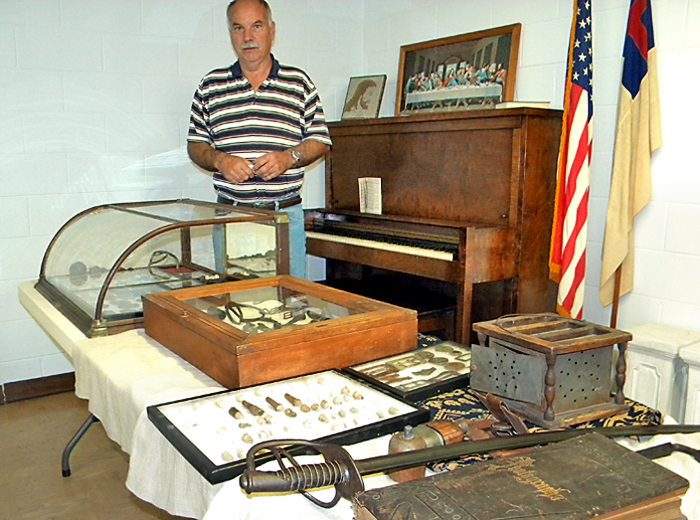 Photo by Randall Higgins
Veteran Civil War relics hunter Billy Nichols brought some of his collection to the monthly Charleston/Calhoun/Hiwassee Historical Society meeting Sunday afternoon. The society outlined plans to re-enact the 1861 burning of the Hiwassee River railroad bridge by Union sympathizers.
Photo by Randall Higgins
Veteran Civil War relics hunter Billy Nichols brought some of his collection to the monthly Charleston/Calhoun/Hiwassee Historical Society meeting Sunday afternoon. The society outlined plans to re-enact the 1861 burning of the Hiwassee River railroad bridge by Union sympathizers.CHARLESTON, Tenn. - They're going to burn the Hiwassee River railroad bridge here - again.
Plans for the 150th anniversary re-enactment of the November 1861 bridge burning by Union sympathizers were outlined Sunday by the Charleston/Calhoun/Hiwassee Historical Society.
Dr. Neil Greenwood, history professor at Cleveland State Community College, spoke about how the original 1861 event was a plot to cut the East Tennessee and Georgia Railroad that linked Virginia to the lower South through Knoxville.
But after the bridge was burned, Union soldiers did not arrive as expected to secure the area. The vital crossing changed hands several times, and other bridges were built and burned. Finally, Union forces built two blockhouses and a redoubt to guard the Hiwassee River bridge late in the war.
This time around, about 1,000 fifth-graders are expected on Nov. 4 to visit re-enactor camps for both Confederates and Unionists. Then on Saturday, Nov. 5, a mock-up of the bridge will be set afire.
Charleston and Bradley County were "twice cursed" by the war, Greenwood said, because of the bridge's strategic location and because of deeply divided loyalties in the community.
The anguish here, he said, was deeper than many communities, including Gettysburg in Pennsylvania.
"For Gettysburg, there was a major battle, and then it was pretty much over," he said.
Here, he said, control of the community often changed hands and thus power alternated throughout the war.
"Life is very difficult when you don't know which army is going to be coming through," he said.
Joe Barkley, dressed in authentic uniform to represent Maj. Joseph C. Manigault from the 2nd South Carolina Calvary, appealed for volunteers. Re-enactors, both men and women, are needed.
"Was there a major battle here? No," Barkley said. "But Charleston was very important, strategically and tactically."
"Don't let the memories of those who struggled fade away," he said.
Faye Callaway, society president, said the November event is an opportunity "to tell students about the Civil War on their doorsteps."
"It's not about Charleston or Tennessee," she said. "It's about the United States of America."
